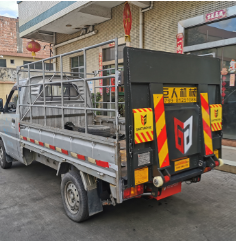1、 Preparation before operation
Vehicle inspection
Before using the car tailboard to load and unload goods, ensure that the vehicle is in a safe parking state. Check if the handbrake of the vehicle is tightened, if the gear is in park (automatic) or neutral (manual), and if the wheels are secured with triangular blocks to prevent the vehicle from slipping.
Carefully inspect the appearance of the tailboard to see if there are any obvious damages, deformations, or loose components. Special attention should be paid to whether there is any leakage in the oil pipes of the hydraulic system, as hydraulic oil leakage may cause the tailboard to malfunction and even lead to safety accidents.
Goods preparation

Understand the weight, size, and shape of the goods. Ensure that the weight of the goods is within the rated load-bearing range of the tailboard. If the goods are overweight, it may damage the tailboard and even cause it to collapse, resulting in casualties and property damage.
For goods with irregular shapes or easy rolling, fixed measures should be taken in advance, such as using ropes, wooden wedges, etc., to prevent the goods from shifting during loading and unloading.
2、 Operation steps for loading and unloading goods
Lower the tailboard
Turn on the power switch of the tailboard and start the hydraulic system. Operate the tailboard lowering button to slowly lower the tailboard to contact the ground. During the descent process, it is important to constantly observe the operation of the tailboard to ensure a smooth descent. If the tail board does not descend smoothly, such as jamming or shaking, the operation should be stopped immediately and the cause should be checked.
Placing goods
After the tailboard is completely lowered, place the goods steadily on the tailboard. For heavier goods, forklifts or pallet trucks can be used to push the goods onto the tailboard. When placing goods, attention should be paid to the distribution of the center of gravity of the goods, and the center of gravity of the goods should be as close as possible to the center of the tailboard to avoid excessive force on one side of the tailboard.
Raise the tailboard
After placing the goods, operate the tailboard up button to slowly raise the tailboard. During the lifting process, it is also important to observe the operation of the tailboard. If you hear abnormal sounds, such as abnormal noise from a hydraulic pump or metal friction, stop operating in a timely manner and check the mechanical components and hydraulic system of the tailboard.
Loading and unloading goods into the carriage
When the tailboard rises to level with the carriage, carefully push or pull the cargo into the carriage. If manual handling is required, attention should be paid to the handling posture to avoid accidents such as sprains. After all the goods enter the carriage, they should be stacked and fixed reasonably to prevent them from shaking during transportation.
3、 Precautions after operation
Lower the tailboard and turn off the power
After loading and unloading, operate the tailboard lowering button to lower and retract the tailboard. Turn off the power switch of the tailboard to save energy and prevent misoperation.
Inspection and Cleaning
Check the surface of the tailboard for any residual or damaged goods. If there is, it should be cleaned and repaired in a timely manner. At the same time, check whether the various components of the tailboard are in place and whether the oil pipes of the hydraulic system are normal. Regularly cleaning the tailboard can extend its service life and reduce the occurrence of malfunctions.

Professional to provide security
for modern logistics
A new company that efficiently handles
and unloads equipment
Please do not hesitate to contact us
0769-81251088

Add friend consultation